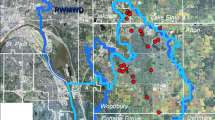Abstract
Compensatory mitigation has been a keystone of state and federal programs for regulating wetland loss. This study reviewed mitigation performance in Indiana, USA to propose mitigation ratios (area to be mitigated/area permitted for fill) based on the rate of wetland establishment by type. Between 1986 and 1996, the Indiana Department of Environmental Management (IDEM) required 345 mitigation sites. Of these, applicants constructed 214 of the sites; another 70 were not completed. No attempt was made to construct the required mitigation on 49 of the sites. Measurements of both the total wetland area and the area of each vegetation community in the mitigation site were taken at 31 of the sites identified as “constructed.” IDEM required 34.33 ha to compensate for the 13.73 ha of state waters lost through the permit actions associated with these sites. The mapping effort found that a total of 15.21 ha of wetland and other waters had established, a net gain of 1.48 ha. Vegetation community mapping revealed that palustrine forested areas, which had a failure rate of 71% and wet meadow areas (87% failure) were harder to establish than shallow marsh areas (17% failure) and open water areas (4% failure). These results suggest that federal and state regulatory agencies would have to require minimum mitigation ratios of 3.5∶1 for palustrine forested, 7.6∶1 for wet meadow, 1.2∶1 for shallow marsh, and 1∶1 for open water to compensate for the risk of failure. Additional mitigation may be needed to offset the effects of temporal loss of wetland function.
Similar content being viewed by others
Literature Cited
Brinson, M. M. 1993. A hydrogeomorphic classification for wetlands. U.S. Army Corps of Engineers, Waterways Experiment Station, Vicksburg, MS, USA. Wetland Research Program Technical Report WRP-DE-4. http://www.wes.army.mil/el/wetlands/ wlpubs.html
Eliot, W. 1985. Implementing mitigation policies in San Francisco Bay: a critique. California State Coastal Conservancy, Oakland, CA, USA.
Environmental Laboratory. 1987. Corps of engineers wetlands delineation manual. U.S. Army Corps of Engineers, Wetland Research Program, Vicksburg, MS, USA. Technical Report Y-87-1. http://www.wes.army.mil/el/wetlands/wlpubs.html
Erwin, K. L. 1991. An evaluation of wetland mitigation in the South Florida Water Management District. Vol. 1. Contract #C89-0082-A1. South Florida Water Management District, West Palm Beach, FL, USA. http://www.aswm.org/mitigation/erwin91.pdf
Gallihugh, J. L. 1998. Wetland mitigation and 404 permit compliance. Vol. 2. U.S. Fish and Wildlife Service, Chicago, IL, USA. http://www.aswm.org/mitigation/gallihugh98.pdf
Gwin, S. E., M. E. Kentula, and P. W. Shaffer. 1999. Evaluating the effects of wetland regulation through hydrogeomorphic classification and landcape profiles. Wetlands 19:477–489.
Johnson, P. A., D. L. Mock, E. J. Teachout, and A. McMillan. 2000. Washington State wetland mitigation evaluation study. Phase 1: compliance. Washington State Department of Ecology, Olympia, WA, USA. Publication No. 00-06-016. http://www.ecy.wa.gov/biblio/0006016.html
Kentula, M. E., J. C. Sifneos, J. W. Good, M. Rylko, and K. Kunz 1992. Trends and patterns in section 404 permitting requiring compensatory mitigation in Oregon and Washington, USA. Environmental Management 16:109–199.
King, D. M. and C. C. Bohlen. 1994. Estimating the costs of restoration. National Wetlands Newsletter 16(3):3–8.
Kunz, K., M. Rylko, and E. Somers. 1988. An assessment of wetland mitigation practices in Washington State. National Wetlands Newsletter 10(3):2–4.
Magee, T. K., T. L. Ernst, M. E. Kentula, and K. A. Dwire. 1999. Floristic comparison of freshwater wetlands in an urbanizing environment. Wetlands 19:517–534.
Mockler, A., L. Casey, M. Bowles, N. Gillen, and J. Hansen. 1998. Results of monitoring King County wetland and stream mitigations. King County Department of Development and Environmental Services, Renton, WA, USA. http://www.aswm.org/mitigation/ mockler98.pdf
National Climatic Data Center. 2000. Climate of 1999. U.S. Regional and Statewide Analyses. Includes December Summary and Drought Update. National Oceanic and Atmospheric Administration, Asheville, NC, USA. http://www.ncdc.noaa.gov/ol/climate/research/1999/ann/us-regional.html
National Research Council. 2001. Compensating for Wetland Losses Under the Clean Water Act. National Academy Press, Washington, DC, USA. http://www.nap.edu/catalog/10134.html
Race, M. S. 1985. Critique of present wetlands mitigation policies in the United States based on an analysis of past restoration projects in San Francisco Bay. Environmental Management 9:71–82.
Race, M. S. and M. S. Fonseca. 1996. Fixing compensatory mitigation: what will it take? Ecological Applications 6:94–101.
Redmond, A. 1992. How successful is mitigation? National Wetlands Newsletter 14(1):5–6.
Sibbing, J. M. 1997. Mitigation’s role in wetland loss. National Wetlands Newsletter 19(1):17–21.
Sifneos, J. C., M. E. Kentula, and P. Price. 1992. Impacts of selection 404 permits requiring compensatory mitigation of freshwater wetlands in Texas and Arkansas. The Texas Journal of Science 44: 475–485.
Storm, L. and J. Stellini. 1994. Interagency follow-through investigation of compensatory wetland mitigation sites. Joint Agency Staff Report, U.S. Environmental Protection Agency, Region 10. Water Division, Wetlands Section, Seattle, WA, USA and U.S. Fish and Wildlife Service, Ecological Services, Washington, DC, USA. EPA 910-R-94-013.
Author information
Authors and Affiliations
Corresponding author
Rights and permissions
About this article
Cite this article
Robb, J.T. Assessing wetland compensatory mitigation sites to aid in establishing mitigation ratios. Wetlands 22, 435–440 (2002). https://doi.org/10.1672/0277-5212(2002)022[0435:AWCMST]2.0.CO;2
Received:
Revised:
Accepted:
Issue Date:
DOI: https://doi.org/10.1672/0277-5212(2002)022[0435:AWCMST]2.0.CO;2




